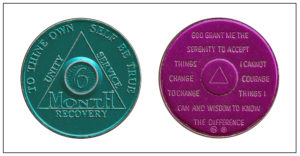An overview of a typical AA meeting structure.
Businessmen do research on their prospects before sitting down to pitch them. Parents research neighborhood crime rates and school ratings before moving into a new home. Some people simply like to be prepared, and there is nothing wrong with that. Even those who struggle with addiction make like to know what they are getting into when attending an AA meeting. The following breakdown of an AA meeting’s structure will help provide insight to those who are new to Alcoholics Anonymous.
AA Meeting Structure
When it comes to the beginning and ending, most AA meetings follow the same general structure. However, each meeting is individually run and may differ some based on the group’s specific needs and interests. For instance, an AA Agnostics group may not say all of the prayers that are usually recited. As a reference point, the following elements make up a typical AA meeting:
- AA Preamble
- Moment of Silence
- Serenity Prayer
- Newcomers Intro
- “How It Works” readings
- Meeting Sharing & Discussion
- 7th Tradition Contribution
- Closing Prayer
What do they say at the beginning of AA meetings?
The very first thing that is recited at a typical Alcoholics Anonymous meeting is the AA Preamble. The Preamble is a short reading that states what AA is, what the purpose, is, and what the requirements are.
AA Preamble:
ALCOHOLICS ANONYMOUS is a fellowship of men and women who share their experience, strength and hope with each other that they may solve their common problem and help others to recover from alcoholism. The only requirement for membership is a desire to stop drinking. There are no dues or fees for A.A. membership; we are self-supporting through our own contributions. A.A. is not allied with any sect, denomination, politics, organization or institution; does not wish to engage in any controversy; neither endorses nor opposes any causes. Our primary purpose is to stay sober and help other alcoholics to achieve sobriety.
Although the AA Preamble is the first thing they say at the beginning of AA Meetings, there are a few other things said before they get to the topic of the meeting. After a moment of silence, the Serenity Prayer is recited, typically as a group:
Serenity Prayer
God, grant me the Serenity to accept the things I cannot change, Courage to change the things I can, and Wisdom to know the difference.
Living one day at a time, Enjoying one moment at a time, Accepting hardship as a pathway to peace, Taking, as Jesus did, This sinful world as it is, Not as I would have it, Trusting that You will make all things right, If I surrender to Your will, So that I may be reasonably happy in this life, And supremely happy with You forever in the next.
Amen.
Next, the leader will ask if there are any newcomers. The newcomers are given an opportunity to introduce themselves, and in some cases, all members partake in introductions. This is not a time to share a long story, but to tell the group your name. It is not required, but the individuals may identify themselves as an addict if they so choose. In some instances, the members also share their sobriety date.
As the last element before beginning the meeting topic, a “How It Works” reading may be recited.
What do they say at the end of an AA Meeting?
After the sharing and discussion part of an AA meeting is completed, there are just things done to close out the meeting. The first is the 7th Tradition collection and the last is a closing prayer.
The 7th tradition states “Every A.A. group ought to be fully self-supporting, declining outside contributions.” This means that it is the member’s own contributions that fund the meetings. This includes purchasing any chips, materials, and refreshments provided during the meetings. No one is required to contribute. In fact, many groups suggest that first-timer refrain from contributing.
The closing prayer is typically the “Our Father Prayer”:
Our Father, Who Art in Heaven,
Hallowed be Thy Name.
Thy Kingdom come, Thy Will be done
On earth as it is in Heaven.
Give us this day our daily bread,
And forgive us our trespasses,
As we forgive those who trespass
against us.
Lead us not into temptation,
But deliver us from evil,
For Thine is the Kingdom, and the Power,
and the Glory Forever and ever.Amen.
Once this prayer is completed, the meeting is concluded and the members disperse. They may grab a snack to go, stay and talk with other members for a little, go leave and go about their business.






